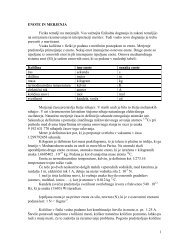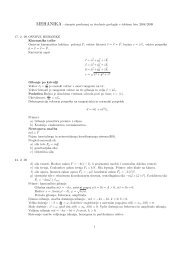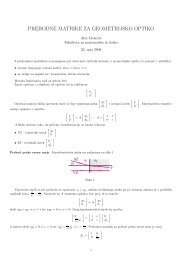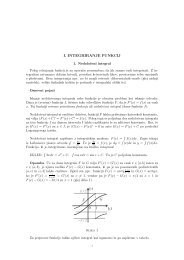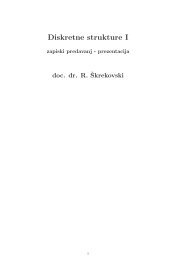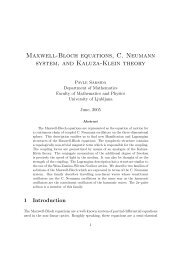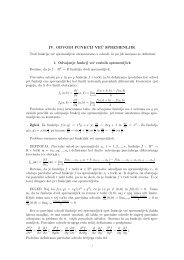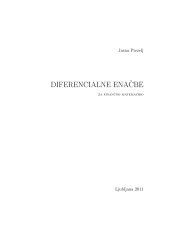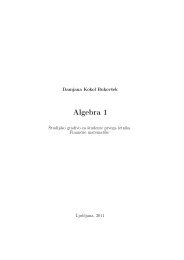Patrick S. Hagan How mathematical finance is used in practice ...
Patrick S. Hagan How mathematical finance is used in practice ...
Patrick S. Hagan How mathematical finance is used in practice ...
You also want an ePaper? Increase the reach of your titles
YUMPU automatically turns print PDFs into web optimized ePapers that Google loves.
<strong>Patrick</strong> S. <strong>Hagan</strong><br />
<strong>How</strong> <strong>mathematical</strong> <strong>f<strong>in</strong>ance</strong> <strong>is</strong> <strong>used</strong> <strong>in</strong> <strong>practice</strong><br />
• Manag<strong>in</strong>g smile r<strong>is</strong>ks<br />
a) Basics: d<strong>is</strong>count factors, FRAs, swaps, and other delta products<br />
b) Curve stripp<strong>in</strong>g, bucket deltas, and manag<strong>in</strong>g IR r<strong>is</strong>ks<br />
c) Mart<strong>in</strong>gales & the fundamental theorem<br />
d) Vanilla options (caps, floors, and swaptions) & mart<strong>in</strong>ga<br />
e) Vol matrices, bucket vegas, and manag<strong>in</strong>g vol r<strong>is</strong>ks<br />
f) Smiles, local volatility models, and equivalent volatilities<br />
g) M<strong>is</strong>hedg<strong>in</strong>g, and the development of the stochastic vol model<br />
h) Us<strong>in</strong>g the SABR model to manage volatility smiles, hedg<strong>in</strong>g stability<br />
i) Levy based models for manag<strong>in</strong>g volatility surfaces<br />
• Interm<strong>is</strong>sion: Market fundamentals<br />
a) money vs. scrip<br />
b) holiday calendars, bus<strong>in</strong>ess day rules, and schedule generation<br />
c) day count fractions<br />
d) ref rates<br />
• Manag<strong>in</strong>g exotic r<strong>is</strong>ks<br />
a) Three elements to modern pric<strong>in</strong>g: model, calibration, and evaluation<br />
b) Choos<strong>in</strong>g a model and the five ma<strong>in</strong> <strong>in</strong>terest rate r<strong>is</strong>ks<br />
c) HJM models – strengths, weaknesses, usage<br />
d) BGM/LMM models – strengths, weaknesses, usage<br />
e) Short rate models – strengths, weaknesses, usage<br />
f) Markovian models – strengths, weaknesses, usage<br />
g) Summary<br />
• Practical pric<strong>in</strong>g of exotics<br />
a) LGM model<br />
b) Callable swaps (Bermudans)<br />
c) Calibration strategies and the selection of calibration <strong>in</strong>struments<br />
d) Connection between calibration <strong>in</strong>struments and vega r<strong>is</strong>ks<br />
e) Explicit calibrations for Bermudan<br />
f) Predicted vs. actual vol matrices for different calibrations<br />
g) Dependence of Bermudan price on choice of calibration <strong>in</strong>struments<br />
h) Dependence of hedges on calibration choices<br />
i) Conclusions
• Adjusters and r<strong>is</strong>k migration<br />
a) M<strong>is</strong>-hedg<strong>in</strong>g, m<strong>is</strong>-pric<strong>in</strong>g, and the need for r<strong>is</strong>k migrators<br />
b) Price sharpen<strong>in</strong>g via adjusters<br />
c) Example: Correct<strong>in</strong>g a Bermudan calibrated to ATM swaptions<br />
d) Example: Correct<strong>in</strong>g a Bermudan calibrated to caplets<br />
• Pric<strong>in</strong>g/hedg<strong>in</strong>g callable range notes & accrual swaps<br />
a) Def<strong>in</strong>ition of the deal<br />
b) M<strong>is</strong>matched payoffs & convexity corrections<br />
c) Us<strong>in</strong>g replication to price non-callable range notes<br />
d) LGM model and potential calibration strategies<br />
e) Potential m<strong>is</strong>hedg<strong>in</strong>g of swaption or caplet r<strong>is</strong>ks<br />
f) Us<strong>in</strong>g <strong>in</strong>ternal adjusters to correct prices and hedges



